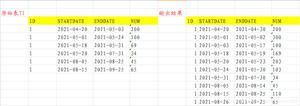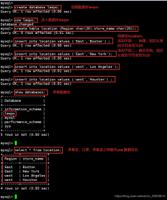SQL子查询的感悟

postgres=# createtable t1(id intprimarykey, info text, reg_time timestamp);CREATETABLEpostgres
=# createtable t2(id int, name text);CREATETABLEpostgres
=# insertinto t1 select generate_series(1, 10000),"lottu", now();INSERT010000postgres
=# insertinto t2 select (random()*1000)::int, "lottu"||id from generate_series(1,1000) id;INSERT01000postgres
=# createindex ind_t1_id on t1(id);CREATEINDEX
select*from t1 where id in (select id from t2);
postgres=# explain (analyze,verbose,costs,timing) select*from t1 where id in (select id from t2);QUERY
PLAN----------------------------------------------------------------------
Merge Join (cost=54.25..99.73 rows=628 width=18) (actual time=1.319..2.365 rows=628 loops=1)
Output: t1.id, t1.info, t1.reg_time
InnerUnique: true
Merge Cond: (t1.id = t2.id)
->Index Scan using ind_t1_id onpublic.t1 (cost=0.29..337.29 rows=10000 width=18) (actual time=0.014..0.421 rows=997 loops=1)
Output: t1.id, t1.info, t1.reg_time
-> Sort (cost=53.97..55.54 rows=628 width=4) (actual time=1.298..1.387 rows=628 loops=1)
Output: t2.id
Sort Key: t2.id
Sort Method: quicksort Memory: 54kB
-> HashAggregate (cost=18.50..24.78 rows=628 width=4) (actual time=0.730..0.877 rows=628 loops=1)
Output: t2.id
GroupKey: t2.id
-> Seq Scan onpublic.t2 (cost=0.00..16.00 rows=1000 width=4) (actual time=0.013..0.267 rows=1000 loops=1)
Output: t2.id
Planning Time: 0.454 ms
Execution Time: 2.507 ms
(17 rows)
从该执行计划可以看到很多信息;
- 其中获取的行数只有62
- 执行时间是
postgres=# explain (analyze,verbose,costs,timing) select t1,*from t1 , t2 where t1.id = t2.id ;QUERY
PLAN------------------------------------------------------------------------------------------------------------------------------------
Merge Join (cost=66.11..117.17 rows=1000 width=72) (actual time=0.601..2.184 rows=1000 loops=1)
Output: t1.*, t1.id, t1.info, t1.reg_time, t2.id, t2.name
Merge Cond: (t1.id = t2.id)
->Index Scan using ind_t1_id onpublic.t1 (cost=0.29..337.29 rows=10000 width=60) (actual time=0.021..0.726 rows=997 loops=1)
Output: t1.*, t1.id, t1.info, t1.reg_time
-> Sort (cost=65.83..68.33 rows=1000 width=12) (actual time=0.573..0.721 rows=1000 loops=1)
Output: t2.id, t2.name
Sort Key: t2.id
Sort Method: quicksort Memory: 71kB
-> Seq Scan onpublic.t2 (cost=0.00..16.00 rows=1000 width=12) (actual time=0.013..0.226 rows=1000 loops=1)
Output: t2.id, t2.name
Planning Time: 0.288 ms
Execution Time: 2.421 ms
(13 rows)
postgres=# explain (analyze,verbose,costs,timing) select*from t1 where id =any(array(select id from t2));QUERY
PLAN---------------------------------------------------------------------------------------------------------------------------
Index Scan using ind_t1_id onpublic.t1 (cost=16.29..59.03 rows=10 width=18) (actual time=0.418..1.108 rows=628 loops=1)
Output: t1.id, t1.info, t1.reg_time
Index Cond: (t1.id =ANY ($0))
InitPlan 1 (returns $0)
-> Seq Scan onpublic.t2 (cost=0.00..16.00 rows=1000 width=4) (actual time=0.014..0.127 rows=1000 loops=1)
Output: t2.id
Planning Time: 0.106 ms
Execution Time: 1.178 ms
(8 rows)
select*from t1 where id in (select id from t2 where id <=1000);或者
with t as(
select id from t2 where id <=1000)select t1.*from t1 where id in (select id from t);
我建议可以用一个子表用来存放
select id from t2 where id <=1000);
以上是 SQL子查询的感悟 的全部内容, 来源链接: utcz.com/z/533692.html








